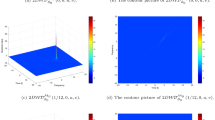Abstract
Two procedures are developed here to compute the Peak-to-Average envelope power Ratio (PAR) of the continuous signal with N subcarriers in the Orthogonal Frequency Division Multiplexing (OFDM) and Discrete MultiTone (DMT) systems. The first one is an accurate computation method for small N, in which the peak of the Instantaneous Envelope Power Function (IEPF) is obtained by solving the roots of a polynomial, a linear sum of a set of Chebyshev polynomials of the first kind and the second kind. The second procedure, called Stepwise Refinement Algorithm (SRA), is a highly precise and fast computation method for arbitrary N by using Inverse Fast Fourier Transform (IFFT), the Chirp Z-Transform (CZT) and a newly introduced relationship between the IEPF peak and its most adjacent oversampled sample.
Similar content being viewed by others
References
W. Y. Zou, Y. Wu, COFDM: An overview, IEEE Trans. on Broadcasting, 41(1995)1, 1–8.
H. Ochiai, H. Imai, On the distribution of the peak-to-average power ratio in OFDM signals, IEEE Trans. on Commun., 49(2001)2, 282–289.
S. Wei, D. L. Goeckel, P. E. Kelly, A modern extreme value theory approach to calculating the distribution of the peak-to-average power ratio in OFDM systems, Proc. of IEEE International Conference on Communications, New York, 2002, Vol.3, 1686–1690.
S. Müller, R. Bäuml, R. Fischer, J. Huber, OFDM with reduced peak-to-average power ratio by multiple signal representation, Annals of Telecommunications, 52(1997)1–2, 58–67.
H. Ochiai, H. Imai, Performance analysis of the deliberately clipped OFDM signals, IEEE Trans. on Commun., 50(2002)1, 89–101.
D. Wulich, Comments on the peak factor of sampled and continuous signals, IEEE Communications Letters, 4(2000)7, 213–214.
M. Sharif, M. Gharavi-Alkhansari, B. H. Khalaj, On the peak-to-average power of OFDM signals based on oversampling, IEEE Trans. on Commun., 50(2003)1, 72–78.
G. Wunder, H. Boche, Peak value estimation of bandlimited signals from their samples, noise enhancement, and a local characterization in the neighborhood of an extremum, IEEE Trans. on Signal Processing, 51(2003)3, 771–780.
C. Tellambura, Computation of the continuous-time PAR of an OFDM signal with BPSK subcarriers, IEEE Communications Letters, 5(2001)5, 185–187.
ITU, Asymmetric Digital Subscriber Line (ADSL) Transceivers, ITU Standard, ITU-T, R. G. 992.1, Jun. 1999.
J. Spanier, K. B. Oldham, The Chebyshev polynomials T n(x) and U n(x), Ch.22 in An Atlas of Functions, Washington, DC, Hemisphere, 1987, 193–207.
B. Saffair, Some polynomial extremal problems which emerged in the twentieth century, in Twentieth Century Harmonic Analysis—A Celebration, edited by J. S. Byrnes, Prometheus Inc., Newport, RI; and University of Massachusetts, Boston, USA, Sept. 2001, 201–233.
V. Oppenheim, R. W. Schafer, Discrete Time Signal Processing, Prentice Hall, Englewood Cliffs, NJ, 1989, 623–628.
Hua Yu, Min Chen, Gang Wei, Distribution of the PAR in DMT systems, IEE Electronics Letters, 39(2003)10, 799–801.
M. R. Leadbetter, H. Rootzen, Extremal theory for stochastic processes, Annals of Probability, 16(1988), 431–478.
Author information
Authors and Affiliations
Additional information
Supported by the National Natural Science Foundation of China (No.60072048) and the Doctoral Program Fund of Educational Ministry of China(No.20010561007)
Communication author: Yu Hua, born in 1973, male, Ph.D., lecturer. School of Electronic and Information Engineering, South China University of Technology, Guangzhou 510640, China.
About this article
Cite this article
Yu, H., Lin, Y. & Wei, G. Highly precise and fast computation of the continuous signal PAR in OFDM and DMT systems. J. of Electron.(China) 22, 9–17 (2005). https://doi.org/10.1007/BF02687945
Received:
Revised:
Issue Date:
DOI: https://doi.org/10.1007/BF02687945




